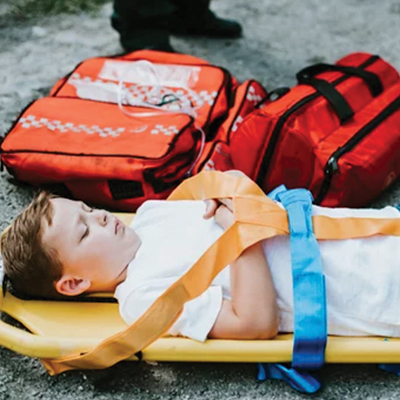Spinal immobilization is one of the most common procedures performed in a prehospital setting. In recent years, emergency medical services (EMS) personnel and patients have benefitted from new research that provides more data on the appropriate occasions for immobilization techniques.
Pediatric patient immobilization and transport have special concerns. Special equipment and care are needed to transport young children to a medical facility safely and effectively. Learn the essentials for proper pediatric patient care.
When to Immobilize a Patient
Immobilization of a patient’s spine is critical when emergency medical technicians (EMTs) are caring for a patient with certain conditions: if the patient has received blunt force trauma, the patient is complaining of neurologic difficulties (tingling extremities, loss of feeling), a deformity of the spine, or an altered mental state. Other serious conditions that warrant spinal immobilization are drug or alcohol intoxication, an inability to communicate, or when it is impossible to evaluate for spinal injuries at the scene. In most of these instances, the cervical spine will also be immobilized with a rigid collar.
Another occasion for spinal immobilization is in a healthcare setting when a patient must undergo an imaging procedure such as x-rays or radiology. Limiting the patient’s movement allows the radiologic technologist to take clearer images and reduces the possibility of a missed diagnosis. It also helps to prevent needless radiation exposure, reducing the radiation dose for both patient and technician. Radiation protection is especially important for children, whose bodies can’t endure the same amount of radiation as an adult.
Immobilization Devices
The most commonly employed device for patient spinal immobilization is the backboard, which acts as a splint for the patient’s entire body and spine. Restricting the spine’s movement reduces the chance of spinal cord injury.
Another form of patient transport is a vacuum mattress, which is an inflatable mattress that cushions a patient and conforms to their body shape. The vacuum mattress allows the patient to be transported in multiple positions, including supine, knees flexed, or an elevated torso position. This is especially helpful for elderly patients who may be uncomfortable lying flat on their backs or patients with severe injuries to their back or pelvis.
Immobilization Vs. Restraint
The word “immobilization” is used to refer to the act of keeping a patient still with their consent, while “restraint” refers to using either physical force or a device to keep a patient still without their consent.
Restraining patients, especially children, is only done as a last resort when the patient is extremely uncooperative and/or poses a threat to themselves or emergency care providers. Even still, using other techniques for immobilization such as distraction, verbal assurance, swaddling, velcro straps, or sandbags is preferable to physical restraint. The use of physical force can result in unnecessary anxiety and undue stress. If the child needs to be restrained as part of a radiography procedure, it is best to delay the procedure until the child has calmed down.
Pediatric Immobilization Devices
When an immobilization or restraint device is necessary for a child, there are many options available. If the child requires immobilization at the scene, medical personnel can employ pediatric immobilization boards or a pediatric vacuum mattress. Special care must be taken with pediatric patients during backboard transport because their heads are often large compared to their bodies. Their heads can move and roll, causing difficulty with airway management.
Pediatric restraint devices are available in neonatal, infant, and pediatric versions. Each one is designed to handle children of different sizes and weight limits. Bear in mind that the child’s weight may not correspond exactly to how many years old the child is.
Keep Pediatric Patients Safe
Immobilization and restraint are now done on a case-by-case basis. While this doesn’t necessarily void previous research, it does mean that emergency medical workers have more options for transporting patients of all ages safely to a hospital.
If you require pediatric patient immobilization and restraint options, take a look at the selection of devices that we offer at Penn Care. Our immobilization and transport devices can handle patients of any size, from neonatal to full-size adults.



